Pingtan's Dangsheng village transforms wasteland into thriving eco-agricultural hub
en.ptnet.cn | Updated:2025-03-07 | Lin Kongbo, StephanieOnce an abandoned shrimp pond and salt-affected wasteland, a patch of barren land in Dangsheng Village, Pingtan, southeastern China's Fujian province, has undergone a remarkable transformation. Through perseverance and innovative ecological farming techniques, it has become one of Pingtan's most promising organic fruit and vegetable bases. The village was recently recognized as a "Fujian Provincial Model for Rural Revitalization."
From Unusable Land to Bountiful Harvests
"No one believed this land could grow anything," recalls Gao Ming, party secretary of Dangsheng Village, standing in the midst of the village's thriving eco-farm. Over 30 years ago, this 35-mu plot was a tidal flat naturally irrigated by the sea. Villagers converted it into shrimp ponds, but with a land reclamation project, seawater was cut off, rendering the ponds deserted.
"The village wanted to develop, but we lacked resources," Gao explains. In 2022, determined to repurpose the land, he initiated an ambitious soil rehabilitation project. The biggest challenge? Sourcing suitable soil. The village mobilized residents to collect construction debris, dredge river sediments, and even transport soil from roadside construction sites. "We layered crushed stones to prevent subsidence, mixed broken ceramic tiles for aeration," Gao says, pointing to the layers of soil beneath him. "Our trucks made over 200 trips just to bring in enough soil.
Soil improvement was just the first step. Gao and the villagers established the Pingtan Taisheng Agricultural Development Company. They expanded the eco-farm from 35 to 90 mu, experimenting with various organic crops such as grapes and oranges.
However, the harvest in 2023 was disappointing, with lower-than-expected yields and subpar quality. "It was heartbreaking," Gao admits. "Villagers had invested their savings, and expectations were high." After consulting agricultural experts, the culprit was identified: incomplete desalination of the soil caused root burn, stunting plant growth.
Scientific Solutions Bring New Growth
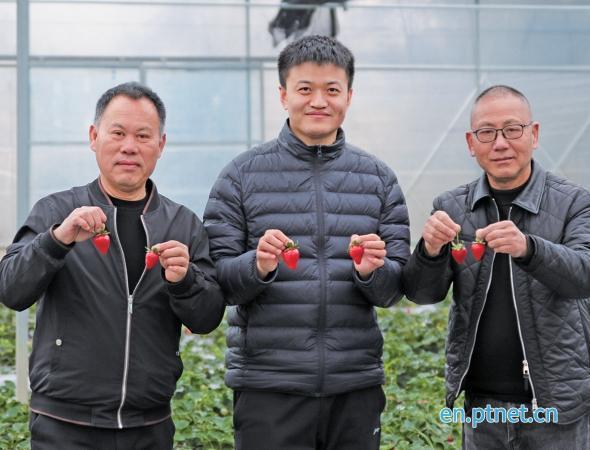
A bountiful harvest at the garden, with Gao Jinru (left), Sun Jichao (center), and Gao Ming (right) posing for a photo inside the greenhouse
In January 2024, Sun Jichao, an agricultural PhD graduate, was assigned as an assistant to the village's Party branch. Identifying soil quality as the key issue, he suggested a research trip to Qingzhou, Shandong. Gao and Sun traveled there with soil samples in search of solutions. "We discovered that Qingzhou farmers use a specially formulated nutrient substrate to regulate soil pH and increase organic content," Sun explains. Inspired, they introduced the method to Dangsheng, combining it with advanced irrigation techniques to rejuvenate the land.
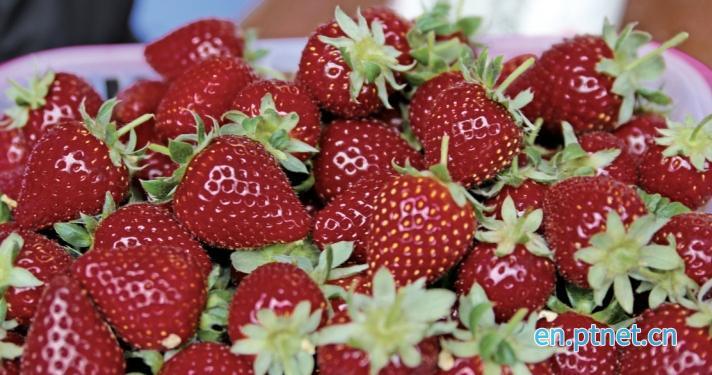
"Black Pearl" strawberries
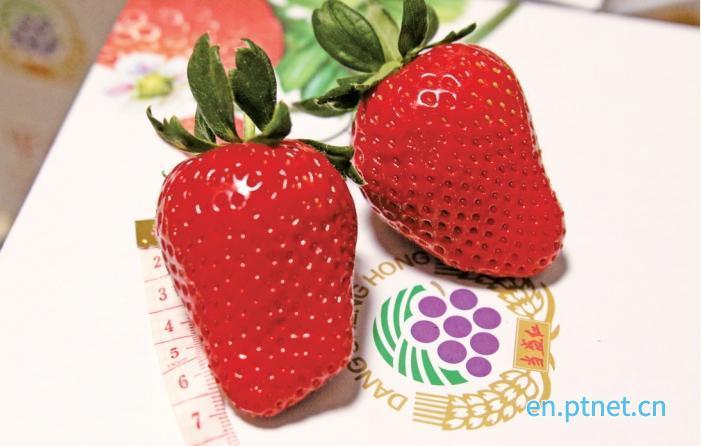
The "Miaoxiang No.7" strawberry can reach up to 7.5 centimeters in length when ripe.
According to farm manager Gao Jinru, through continuous refinement, they successfully cultivated premium strawberry and cherry tomato varieties. "We selected Shandong's 'Miaoxiang No. 7' and 'Black Pearl' strawberries, along with Taiwan's 'Jinfei' and 'Millennium' cherry tomatoes. They not only thrived but developed outstanding flavors, quickly attracting market attention."
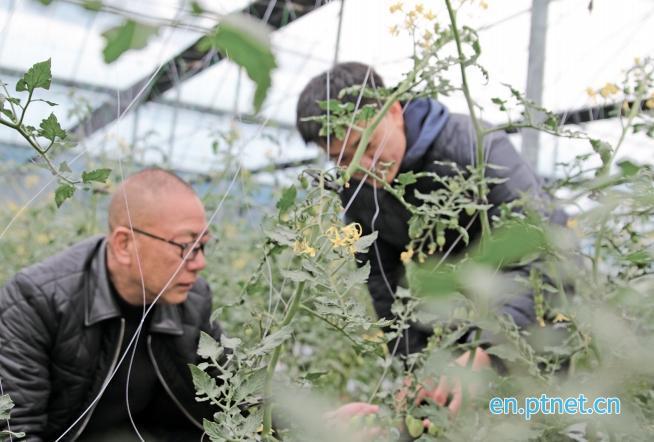
Gao Ming (left) and Sun Jichao (right) examining the growth of cherry tomatoes
In January, the first batch of organic strawberries hit the market—and demand exceeded supply. This spring, the village harvested over 65,000 kilograms of strawberries and cherry tomatoes, generating more than 3 million yuan in revenue.
Technology-driven Organic Farming
"Technology is at the heart of our success," says Sun Jichao. In the organic strawberry greenhouse, he demonstrates the soil improvements. "Look at this," he says, comparing two soil samples. "The untreated soil is yellow, while the improved soil is rich and dark—proof that our desalinization efforts are working." The deeper green color of the strawberry leaves further confirms that the plants are receiving optimal nutrition.
Sun also highlights the greenhouse's climate control system. "The temperature stays around 22°C, with humidity at 60%," he explains. "This ensures that each strawberry grows in the ideal environment."
However, Sun's farming expertise from Shandong did not translate perfectly to Pingtan's coastal conditions. "Intense sunlight, UV exposure, and unpredictable weather make things different here," notes Gao Jinru. To adapt, they abandoned traditional crop rotation, instead using summer's high temperatures to naturally sterilize the soil by sealing the greenhouses—eliminating pests without pesticides. "This step is crucial," Gao says. "It allows us to truly achieve organic farming."
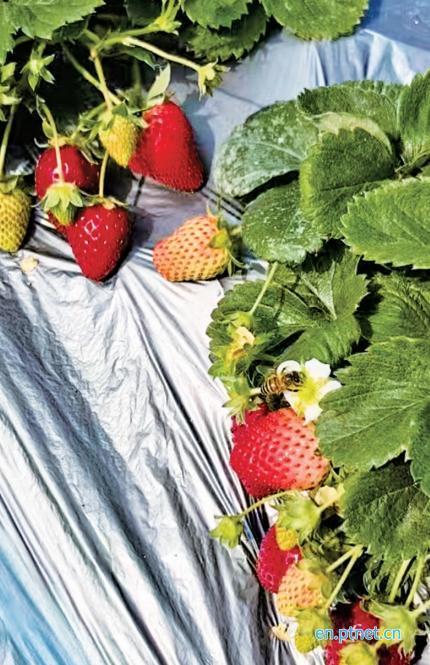
Strawberries pollinated by bees grow larger in size.
Another unique feature of the farm is its natural pollination system. Inside the greenhouses, bees tirelessly work among the strawberry blossoms. "They follow a '007' work schedule—working 24 hours a day, seven days a week—for just a bit of nectar," Sun jokes. Studies confirm that bee pollination improves fruit quality and reduces deformities. "It's an eco-friendly, efficient method that eliminates the need for artificial interventions," he adds.
Thanks to these innovations, Dangsheng Village's organic strawberries have reached exceptional quality. "Miaoxiang No. 7" strawberries grow up to 7.5 cm in length, with individual fruits weighing 30–60 grams—fulfilling the dream of "nine strawberries per jin." The village has also launched its own fruit brand, "Dangsheng Red," marking the beginning of a premium agricultural brand. "Our goal is sustainable, high-quality agriculture that benefits the entire village," says Gao.
From Eco-farming to Agri-tourism: Building a "Strawberry Town"
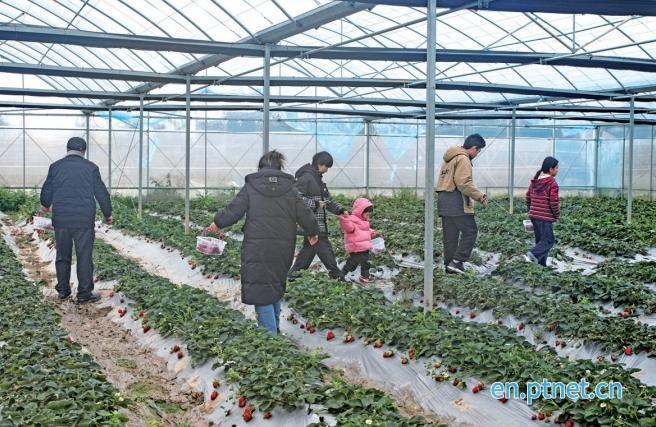
Tourists picking strawberries
Through ecological restoration, technological innovation, and villagers' participation, Dangsheng has paved a path for sustainable development. "Our model is based on integrating eco-agriculture with village-driven growth," Gao explains. Instead of relying on a single industry, the village operates as a collective, with villagers sharing in management and profits through Pingtan Taisheng Agricultural Development Company.
Women have also played a key role in this transformation. Villager Liu Liyu, who once worked far from home, now finds stable employment in the strawberry greenhouses. "I used to struggle to balance work and family," she says. "Now, I earn a good income while staying close to my children."
Looking ahead, Dangsheng is developing a "strawberry town"—an integrated destination combining agriculture, tourism, and cultural experiences. Plans include a fruit-picking zone, rest and dining areas, and fishing spots, offering visitors an immersive farm-to-table journey. "We want tourists to not only pick fruit but also experience organic farming and sustainability firsthand," Gao says.
Standing by a winding stream at the edge of the eco-farm, he gestures toward a future project. "Here, we'll build an open-air tea and coffee lounge, giving visitors a place to relax and enjoy nature." With planning and bidding processes complete, construction will soon begin.
From barren wasteland to thriving agricultural hub, Dangsheng Village has proven that combining ecological restoration with modern technology can turn underutilized land into a sustainable economic asset—offering a blueprint for rural revitalization.

 Fujian Public Security Registration Code: 35012802000271
Fujian Public Security Registration Code: 35012802000271